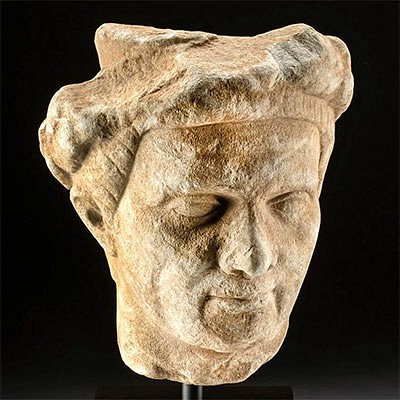Exhibited Roman Glass Footed Sprinkler Flask, Rare Form
Lot 41
About Seller
Artemis Fine Arts
686 S Taylor Ave, Ste 106
Louisville, CO 80027
United States
Selling antiquities, ancient and ethnographic art online since 1993, Artemis Gallery specializes in Classical Antiquities (Egyptian, Greek, Roman, Near Eastern), Asian, Pre-Columbian, African / Tribal / Oceanographic art. Our extensive inventory includes pottery, stone, metal, wood, glass and textil...Read more
Estimate:
$1,300 - $1,950
Absentee vs Live bid
Two ways to bid:
- Leave a max absentee bid and the platform will bid on your behalf up to your maximum bid during the live auction.
- Bid live during the auction and your bids will be submitted real-time to the auctioneer.
Bid Increments
| Price | Bid Increment |
|---|---|
| $0 | $25 |
| $300 | $50 |
| $1,000 | $100 |
| $2,000 | $250 |
| $5,000 | $500 |
| $10,000 | $1,000 |
| $20,000 | $2,500 |
| $50,000 | $5,000 |
| $100,000 | $10,000 |
| $200,000 | $20,000 |
About Auction
By Artemis Fine Arts
Jun 1, 2023
Set Reminder
2023-06-01 10:00:00
2023-06-01 10:00:00
America/New_York
Bidsquare
Bidsquare : Ancient | Asian | Ethno | Native American Art
https://www.bidsquare.com/auctions/artemis-gallery/ancient-asian-ethno-native-american-art-12905
Featuring classical antiquities, ancient, and ethnographic art from cultures encompassing the globe. Egyptian, Greek, Roman, Near Eastern, Asian, Pre-Columbian, Native American, African / Tribal, Oceanic, Spanish Colonial, Fossils, more! All legally acquired, legal to sell. Satisfaction guaranteed. Artemis Fine Arts info@artemisfinearts.com
Featuring classical antiquities, ancient, and ethnographic art from cultures encompassing the globe. Egyptian, Greek, Roman, Near Eastern, Asian, Pre-Columbian, Native American, African / Tribal, Oceanic, Spanish Colonial, Fossils, more! All legally acquired, legal to sell. Satisfaction guaranteed. Artemis Fine Arts info@artemisfinearts.com
- Lot Description
Roman, Imperial period, Eastern Empire, ca. 1st to 3rd century CE. A gorgeous glass sprinkler flask of a rare form with a globular body set on 5 petite feet, surmounted by a thick neck and broad, lipped rim. Petite vertical indentations encircle the corsetted neck line, while layers of weathering film as well as pearly and rainbow iridescence envelop the translucent light green glass, making it appear opaque. The interior of the neck is slightly constricted allowing one to control the flow of liquid being dispensed. Vessels like this example were intended to hold precious liquids such as perfumes or scented oils for cosmetic purposes. The restrained distribution of the oil enables a Roman man or woman to easily tip the glass and only release one or two drops at a time without accidentally dousing themselves in perfume. Note how the dazzling iridescence captivates the viewer, much like the sweet and floral perfumes it once held may have seduced the love interests of the vessel's owner. Size: 2.2" Diameter x 3.7" H (5.6 cm x 9.4 cm)
Most scholars agree that Roman glass was of the highest quality - both aesthetically and technically - among the ancients. While glass making had been practiced for centuries, glass blowing was invented in the Roman-controlled Holy Land in the 1st century BCE. This innovative technology revolutionized the artform. We can appreciate such a wide variety of forms and shapes, because the medium of glass has unique physical properties that make for so many more possibilities than metal or clay. Roman glassmakers reached incredible artistic heights with both free-blown vessels and mold blown forms and decorations.
Exhibited in "Ancient Glass: Selections from the Richard Brockway Collection" at the Hallie Ford Museum of Art at Willamette University, Salem from March 10 to May 19, 2007 and "Glass of the Ancient World" at the Vero Beach Museum of Art, Florida from October 11 to December 28, 2008.
Provenance: private Vero Beach, Florida, USA collection, acquired before 2003
All items legal to buy/sell under U.S. Statute covering cultural patrimony Code 2600, CHAPTER 14, and are guaranteed to be as described or your money back.
A Certificate of Authenticity will accompany all winning bids.
We ship worldwide and handle all shipping in-house for your convenience.
#177766Earthen encrustations have sealed narrow interior opening shut, inhibiting use. Some minor chipping to feet and expected surface wear as shown, but otherwise intact with rich earthen deposits, nice weathering film, and beautiful iridescence. Pontil mark on underside of base. A pontil scar or mark indicates that a vessel was free-blown, while the absence of such a mark suggests that the work was either mold-blown or that the mark was intentionally smoothed away or wore away over time.Condition
- Shipping Info
-
All shipping is handled in-house for your convenience. Your invoice from Artemis Gallery will include shipping calculation instructions. If in doubt, please inquire BEFORE bidding for estimated shipping costs for individual items.
-
- Buyer's Premium



 EUR
EUR CAD
CAD AUD
AUD GBP
GBP MXN
MXN HKD
HKD CNY
CNY MYR
MYR SEK
SEK SGD
SGD CHF
CHF THB
THB














